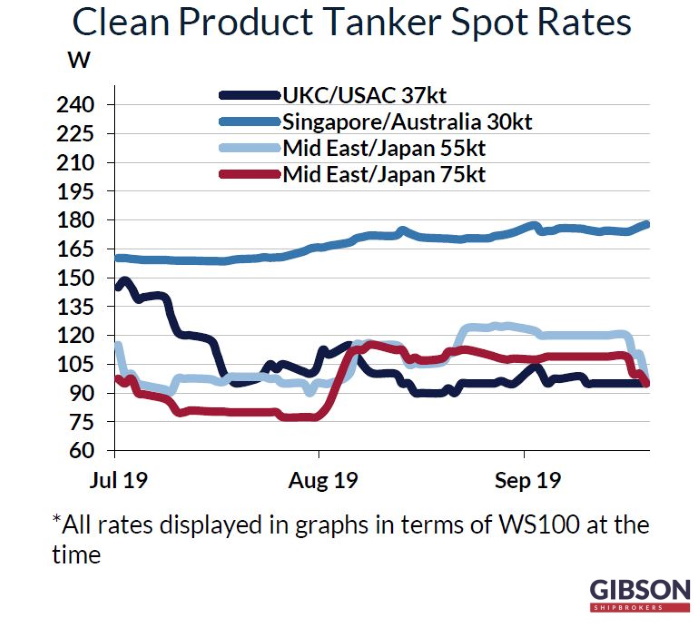Long-Term Outlook Positive for Product Tankers
With big changes coming in the refinery landscape in the future, ship owners active in the clean tanker market stand to benefit from longer ton-mile demand. In its latest weekly report, shipbroker Gibson said that “over the next 5 years, the global refinery landscape will continue to evolve, with the IEA projecting that over 9 million b/d of new capacity will be added, roughly twice the level of refined products demand growth over the same time period. With over two thirds of new capacity being added East of Suez, pressure will grow on older, less complex refineries, many of which are located in Europe. Structural changes in global oil products demand and crude supply will also significantly impact on refining margins and arbitrage, not just in Europe, but globally. In the short term, less complex refineries may lag behind, as new regulations come into play, particularly those that lack the ability to upgrade or desulphurize fuel oil. Some may turn to lower sulphur crudes although price premiums for these grades are likely to rise, impacting upon margins. However, as the refining landscape recalibrates post 2020, other structural changes will come into play. Gasoline exports have proved a key source of profitability for European refineries. However, demand growth is expected to slow in the Atlantic Basin, whilst the potential start-up of Aliko Dangote’s Lekki refinery also threatens to starve off a key outlet for European gasoline”.

According to Gibson, “ultimately, many of the older and less complex refineries in Europe will come under increased regulatory and competitive pressure over the next five years, having to deal with IMO2020 and then fight off competition from newer, more efficient plants, located either close to major demand centres, or close to key sources of feedstock supply. This of course a generalisation, many plants in Europe have invested in cokers, hydrocrackers and solvent de-asphalting units to aid the production of higher quality fuels, whilst there will still be significant exports and regional demand for European products. Nevertheless, newer/more efficient plants in the US, Asia and the Middle East will pressure European Refinery runs lower by 2024, with the IEA projecting a 900,000 b/d decline. Even if global oil products demand surprises to the upside, there is still likely to be excess refining capacity”.


“Changes in the European refining scene will also impact crude trade flows at a time when North Sea crude production is expected to rise. By 2024, Europe is expected to see its crude production increase by 440,000 b/d. However, with refinery utilisation projected to fall, crude exports from the region look set to increase. Imports into the region are also expected to ease back, boosting the overall crude surplus in the Atlantic basin. With the majority new refining capacity being added in the East, shipowners stand to gain from stronger tonne mile demand growth, although shorter and medium haul trading opportunities may well diminish”, Gibson concluded.

Meanwhile, in the crude tanker market this week, in the Middle East, Gibson said that “the week started with a degree of uncertainty after the weekend attack. On the back of this, both some VLCC Owners and Charterers held back until there was some clarity as to how the market would react. One Chinese Charterer dominated the amount of fixing throughout the week, proved to be a wise move. As the week progressed, rates have started to rise gradually. Last done is 270,000mt x ws 69.5 for Far Eastern destinations. With muted interest for Western destinations, it is nearer to mid ws 30’s on 280,000mt. The attacks in Saudi caused mixed reaction from Suezmax Owners; some were hesitant to engage but not enough to alter the scene completely. The more compelling story is action elsewhere and Owners ballasting away from the MEG, which will likely lead to a tonnage deficit further down the line. Rates have settled in the mid ws 30’s for TD23, with upside on the horizon heading into next week. Levels to the East hover around 130,000mt x ws 90. Aframaxes in the AGulf began the week looking flat, trading sideways at 80 x ws 100 levels. However, behind the scenes the market makers were rapidly looking to take cover and by Tuesday/Wednesday an influx of cargoes had flooded the market. Rates are up to 80 x ws 120 for AGulfEast, with potential for further gains”, the shipbroker concluded.
HEADLINES
- Do shipping markets want Biden or Trump for the win?
- All 18 crew safe after fire on Japanese-owned tanker off Singapore
- Singapore launching $44m co-investment initiative for maritime tech start-ups
- Cosco debuts Global Shipping Industry Chain Cooperation Initiative
- US warns of more shipping sanctions
- China continues seaport consolidation as Dalian offer goes unconditional